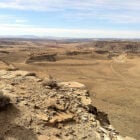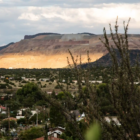Abandoned Uranium
Climate change and the third world, in New Mexico
|
In reporting two recent stories about abandoned uranium mines north of Church Rock, N.M., I heard residents say several times that they want federal officials to take action, not just more talk about cleaning up radioactive waste left practically in their backyards for 40 or more years. I also heard how exhausting it is for the people who live next to this waste to repeatedly tell their stories to people like me, people concerned, even outraged about the situation, but who don’t live there–journalists, government officials, and activists from elsewhere–who have the luxury to come and go. “…sometimes, you get so frustrated talking about these things,” said Edith Hood, a resident who lives in the Red Water Pond Road community near the mines, in remarks to the Nuclear Regulatory Commission at their public meeting in Gallup last Friday. “…we, Indian country, we are like the people that live in the third world, in the United States,” Hood said. “Nobody listens to us.


